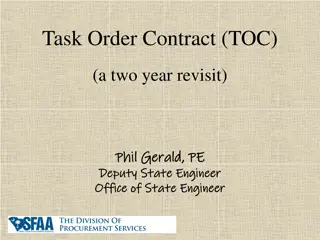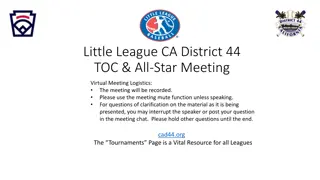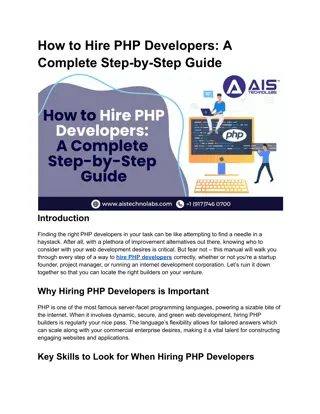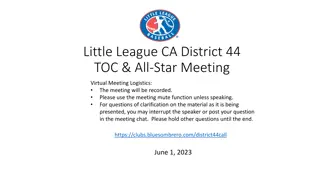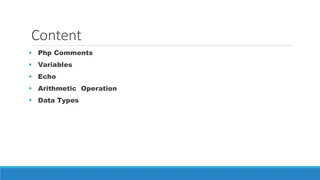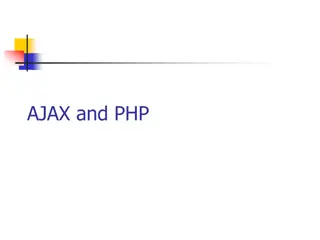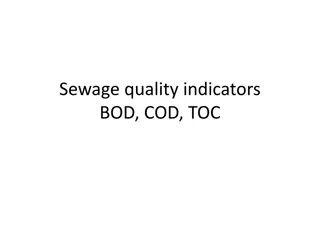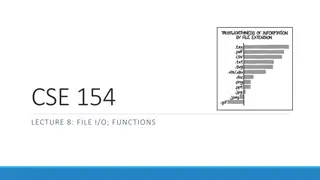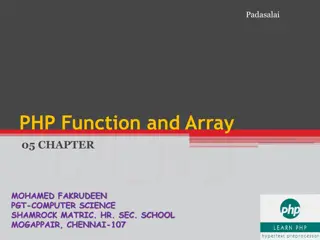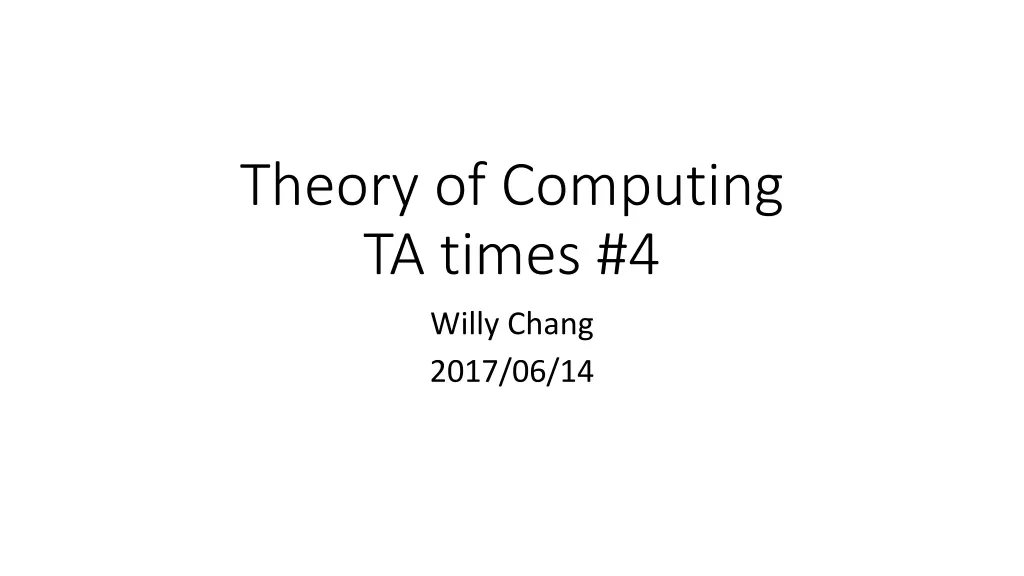
Theory of Computing TA Times #4 Willy Chang 2017/06/14
Explore the solutions and enumerator definitions presented in the Theory of Computing TA Times #4 by Willy Chang on June 14, 2017. Caution: Use the materials as guides, not definitive solutions for homework. Delve into Turing machine definitions and enumerator examples provided in the content.
Download Presentation

Please find below an Image/Link to download the presentation.
The content on the website is provided AS IS for your information and personal use only. It may not be sold, licensed, or shared on other websites without obtaining consent from the author. If you encounter any issues during the download, it is possible that the publisher has removed the file from their server.
You are allowed to download the files provided on this website for personal or commercial use, subject to the condition that they are used lawfully. All files are the property of their respective owners.
The content on the website is provided AS IS for your information and personal use only. It may not be sold, licensed, or shared on other websites without obtaining consent from the author.
E N D
Presentation Transcript
Theory of Computing TA times #4 Willy Chang 2017/06/14
CAUTION CAUTION Most solutions we showed in TA s slides are more like the ideas rather than completed solutions. You may take them as guides, but shouldn t consider them as all the things you need to get your homework done.
HW#8 Q1 We give the definition of the Turing machine as below. ? = ?, ,?,?,?0,???????,???????, where = 0,1 ,? = {0,1,#, } 1 #,? 1 0,? 0 #,? ?0 ?1 ?2 0 1,? #,? 0 ? 1 ? ??????? 0,? 1,?
HW#8 Q2 (1/4) We give an enumerator ? = (?, ,?,?,?0,? ???) as below. ? is a finite set of states. is the output alphabet, not including '#'. ? is the work tape alphabet. ?:? ? ? ? ?,? {#} work tape ?0 is the initial state. ? ??? is the state that stops ?. printer tape
HW#8 Q2 (2/4) When ? operates on the work tape, it may write something as output on the printer tape, including '#', which stands for the separator between output strings. The machine keeps working until it reaches ? ???. The string on printer tape grows in one direction and looks like: C1#C2#C3# ... For any Cithat occurs in the printer tape, it s the member of the enumerated language.
HW#8 Q2 (3/4) As an example, we make the enumerator enumerate the language 12?| ? = 0,1,2, . So strings like 1, 11, 1111 will be enumerated by it while 111, 111111 will not. Since the language is infinite, ? will never stop. Let ? = 0,1, 1, , = {1,?}. The states and the transitions of ? go as follows (We skip the output symbol on the diagram when it s ?.) :
HW#8 Q2 (4/4) 0,1 ? 1,0 ? 1 ? 1, 1 1,?,1 1 1,? 1,? ? 0,? 1,? ?,# ?0 ?1 ?2 ?3 ?4 ?5 ?6 1 ? 1 ?,1 0 1,? ? 1 0,? ?9 ?8 ?7 1 ?
HW#8* Q3 (1/6) Since outside the input portion such TM can do whatever a normal TM does, the restriction on its power will then lie in the read-only part (on input portion). We will show that given one this kind of input read-only machines, its distinguishability on input strings has an upper bound. Since the possible input strings are infinite, if your distinguishability is bounded, you will treat some strings the same. And if we let those strings being treated the same form a group, bounded tells us that we will only have finite groups.
HW#8* Q3 (2/6) In Myhill-Nerode theorem, these groups are called equivalence classes. And according to Myhill-Nerode theorem, if you are talking about a language with finite equivalence classes, you are talking about a regular language. (You can find more details of Myhill-Nerode theorem in the chapter 1 s PROBLEMS section in the textbook.) So by showing the upper bound of the machine's distinguishability on strings, showing it can only separate strings into finite groups, we have showed that such kind of machines can only define/recognize regular languages.
HW#8* Q3 (3/6) Input string ? ? Let us say, on the tape, the input string portion is ? and the rest is ?. With one such machine ?, how many kinds of ? can ? distinguish? ? may cross the boundary between ? and ? several times. Let's say there is a time that ? crosses the boundary, moving from ? to ?, getting into the input portion, doing so on some state ?; and then (if ever) it comes out from the input portion on some state ?. You can find that no matter when, because of the determinism and the read-only constraint, if ? ever enters the input portion ? on state ? again, it will still come out from ? on state ?. The ? here is only decided by ? and the content in ? (unchangable).
HW#8* Q3 (4/6) ? ? Input string Input string So let us write ??? = ? to denote this relationship. If there is another input ? , it would then be ?? . On any possible input ?, the relationship can be denoted as ??: ? ? { } , where ? is the states of the machine ?; and are the pseudo states used as follows: ? ? Input string Input string Input string Input string
HW#8* Q3 (5/6) We need a pseudo state to denote the state that leads to the first head-out-from-? transition since there isn t actually one for that. So if the first head-out move happens on state ?, we have ?? = ?. And we have ??? = for the case that the head never comes out from the input portion again after entering it on state ?. ? ? Input string Input string Input string Input string
HW#8* Q3 (6/6) Now, if there are two input ? and ? having a same relationship table (i.e., ??= ??), ? will treat them the same. Namely, they are undistinguishable to ?; the strings ? and ? fall into the same group. Since the possibilities of ??has an upper bound ( ? + 1)? +1, we ve found an upper bound for the number of groups that ? can separate inputs into, a bound for ? s distinguishability. According to Myhill-Nerode theorem, if ? can only separate strings into finite groups (equivalence classes), ? can only define/recognize a regular language.
HW#8 Q5 ? ? ?? ? ??? ??? ?(?) = . Let ??????= Show that ALLDFAis decidable. Construct a Turing machine M to decide the ALLDFAproblem. M =" On input x, Denote the DFA by A = (Q, , ,q0,F). Construct DFA AC: AC= complement of A. Run <AC> on the Turing machine T that decides the EDFAproblem (Theorem 4.4). If T accepts <AC>, then accept x. If T rejects <AC>, then reject x."
HW#8 Q6 Hints: ?(?) ?(?) ?(?) ?(?) = . We know how to manipulate a DFA. We know how to convert a PDA into its corresponding CFG. (Lemma 2.27) Through Theorem 4.8, we know that ?CFGis a decidable language.
HW#8 Q7 Hints: A ??? does NOT need to have a rule ? ? just in order to generate ?. But a ??? in Chomsky Normal Form does! A ??? ? in Chomsky Normal Form generates ? iff it has the rule ? ?.
HW#9 Q2 (1/2) By contradiction, you will find that this problem is telling you that the language consisting of all descriptions of deciders is not Turing- recognizable. We will construct the proof by diagonalization. Since ? is Turing-recognizable, let ??be a enumerator for ?, just as which we had discussed in Theorem 3.21. And let ?1, ?2, , ??, be the strings that ?? generates. We take in lexicographical order, ?1,?2, ,??, . So for each string of , it has its own order number ?.
?1 ?2 ?? HW#9 Q2 (2/2) ?1 Accept Reject Accept ?2 Accept Accept Reject We define the TM ?? as follows. ??= On any input string ?: 1. Compute the order number ? of ?. 2. Use ??to generate the ?th output ??. 3. Simulate ??on ?. 4. If ??accepts, reject; otherwise, accept. Since every ?? is a decider, ??is a decider; the language ? is a decidable language. But as the diagonalization we ve showed above, ?? ?, i.e., such ? is not decided by any decider ??that were described in ?. Q.E.D. ?? Reject Accept Reject
HW#9 Q3 Hints: The idea is like the one we applied in HW8 Q6. Substring relationships can be described in a regular expression. Run another machine to make use of Theorem 4.8.
HW#9 Q5 This proof is by contradiction. To get the contradiction we assume that ????? is decidable and use this assumption to show that ?????? is decidable. (This proof is similar to that of Theorem 5.4.) If there were a TM ? to decide ?????then we could define a TM ? to decide ??????as follows. ? = On input ? , where ? is a CFG: 1. Run ? on input ?,?1, where G1is a CFG that generates . 2. If ? accepts, accept; if ? rejects, reject. If ? decides ?????, ? decides ??????. But ??????is undecidable by Theorem 5.13, so ?????must be undecidable. Q.E.D.
HW#10 Q2 (1/2) Given a TM M and input w, we can construct a 2DFA M to test if M accepts w. Given a TM D can decide E2DFA, we can decide ETMbased on D. (Reduction: ETM E2DFA) That is, M = On input <M>, 1. Construct a 2DFA M which recognizes the accepting computation history of M. 2. Run D on M . If D accepts, accept. Otherwise, reject. Since ETMis undecidable, we meet a contradiction. E2DFAis undecidable.
HW#10 Q2 (2/2) To construct M : For a TM M and an input w, M accepts an accepting computation history for M on w. We assume a computation history should look like: C1#C2#C3#...#Ck And M will decide the computation history by checking following 2 conditions: 1. C1and Ckare valid start and accepting configurations. Check if C1contains q0and Ckcontains qaccept. 2. For each Ci, Ci+1will legally follow from Ci. Using two heads, we check if the symbol of Ciapplying to the transition function leads to the corresponding position of Ci+1 , L(M)=L( M)=emptyset. If both conditions holds, M accepts. Otherwise, reject.
HW#10* Q4 (1/2) ? = entered on any input string. } We now show that ? is reducible from ???, which is known to be undecidable. Assume that ??is a Turing machine that decides ?; we can construct a Turing machine ? that decides ???(details in the next slide). And by thus, we ve showed that ? is undecidable either. ? ? is a Turing machine having a state that will never be
HW#10* Q4 (2/2) ? = On input ?,? : 1. If the input is not a valid representation of a Turing machine and a string, reject. 2. Construct TM ? = Reject any input except ?, and with input ? run ? on it; accept or reject the same as ? does. 3. Modify ? into ? : whenever ? is about to enter the accept state, we make it enter a set of states that lead it to visit every other state first (except for the reject state), and end in the accept state. This can be done by adding a new tape symbol, writing it to two consecutive cells on the tape, and then moving back and forth on them while visiting other states. 4. Run ??on input ? , reject if it accepts; accept otherwise.











